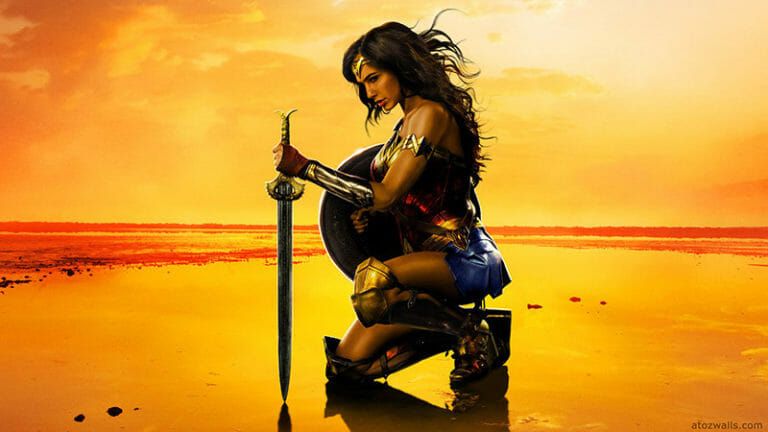By Travis Maiuro · June 6, 2017

Patty Jenkins’ Wonder Woman has received the well-deserved adoration of critics and audiences alike. The film is a much-needed breath of fresh air for not just the DC Universe, but superhero movies in general. It’s gorgeously shot, wonderfully acted, and skillfully directed by Jenkins. And the script, written by Allan Heinberg (with story credits for Heinberg, Zac Snyder, and Jason Fuchs), cleverly avoids the trappings of other superhero origin movies – and we all know there’s been a glut of these origin movies in the past decade. We can argue over the third act and whether it falls into conventionality, but the majority of the script makes intelligent decisions and remains entertainingly original.
Here are a few ways the script excels by using its brains (or Wonder Woman’s brains, for that matter) to change the superhero movie landscape. (Warning: Spoilers ahead)
The film is admittedly a bit lengthy, but that has more to do with the aforementioned last act. In fact, the opening of the film is pleasingly economical. We open on a Young Princess Diana, who will grow up into Wonder Woman, living on a matriarchal island of Amazons. Some may be groaning already – ugh, we’re starting all the way at the beginning? How long’s it going to take until we get to the actual Wonder Woman? But the script does a great job at making such reactions feel premature and unwarranted; it wastes no time in getting to the point.
We receive all the information we need about Diana’s personality with just one scene, and even better, it’s conveyed mainly through action, hardly any dialogue. Young Diana secretly watches the Amazons practice their combat from atop a rocky hill, mimicking their fighting moves. Solely from that we understand what fuels Diana: she wants to learn how to fight. Towards the end of the scene, after Diana is caught, we catch the look on Diana’s Aunt Antiope’s face, and from that look alone we know Diana will have assistance in her goal. Just like that, we have our ingredients to set Diana on her path.
Diana being from an otherworldly island offers the script opportunity to tap into the entertaining “fish out of water” trope. If not used correctly, however, this trope can grow stale fast. But the script uses the technique in more than just one way. Not only does it lighten the mood with truly humorous moments and allow Steve to relay exposition to the audience by cluing Diana in, it also provides opportunity for Diana to argue for peace, her core belief, in a non-preachy way.
Diana cannot understand why war and violence is just accepted as a way of life by these men. Shouldn’t it be the other way around, with peace as the norm? Diana argues. Diana’s thinking is particularly resonant today. It’s her fish-out-of-water-ness that brings her closer to audiences, as it creates a more relevant, culturally aware hero. In one poignant scene, through Diana’s fish-out-of-water eyes, she learns about Steve’s motely crew and, from the Native American character The Chief, of what atrocities Steve’s people are capable.
Speaking of peace, the script-flipping gender roles – female hero, male sidekick – further advances this theme. Where most male heroes fight for revenge, hidden demons, or something of the like, Diana fights to stop war. Literally – her mission is to stop Ares, the god of war. It’s energizing to see Diana drive the plot while Steve takes the backseat normally reserved for the female characters in superhero flicks – creating diversions; taking care of smaller business while Diana takes on the big guns; getting caught in compromising positions (i.e. naked); and sacrificing himself for the sake of our hero.
The script has fun with this flip (particularly that hilarious naked bath scene) and the end result is actually quite subversive. Yet in spite of this, it doesn’t treat the gender role reversal like a big deal – it just is. As if the film itself is unaware of the fact that it’s a game-changer. Simply put, Diana is our hero and that’s the way it should be.
Every good superhero movie needs a MacGuffin, right? Unfortunately though, this well-worn convention isn’t always used as proficiently as one would think. Wonder Woman takes advantage of its World War I time period (which was cleverly changed from the WWII setting of the comics) and uses it as a launching pad for its MacGuffin – Dr. Poison’s secret notebook of nefariousness, which includes instructions on creating ultimate weapons of war. Steve has stolen this notebook, and when Diana’s world entwines with Steve’s, the plot moves forward.
It’s a MacGuffin that doesn’t need much explanation and one that fits nicely into the setting. It feels real, but not in an overwhelming way that prevents the audience from escaping reality (something Chris Nolan’s Dark Knight trilogy was guilty of). It feels real in a classic way – WWI was, after all, the war to end all wars. Of course there would be a notebook of formulae on deadly gases and such! It’s simple, and that’s what it needs to be. The MacGuffin is just something that gets our characters together and into situations. This one happened to throw us into the First World War, a war so far removed from the cultural psyche that it doesn’t seem weird that a superhero helped fight it.
Granted, not all superhero movies will be able to replicate all of these aspects, particularly flipping gender roles (although, if we finally get more female superhero movies, we can get more scripts following this technique!). But hopefully what future superhero scripts take from this is that it’s possible for a comic book movie to have fun and still have something to say. Even with humor, it will still be taken seriously. And that’s what Wonder Woman does best: making comic book movies fun again.